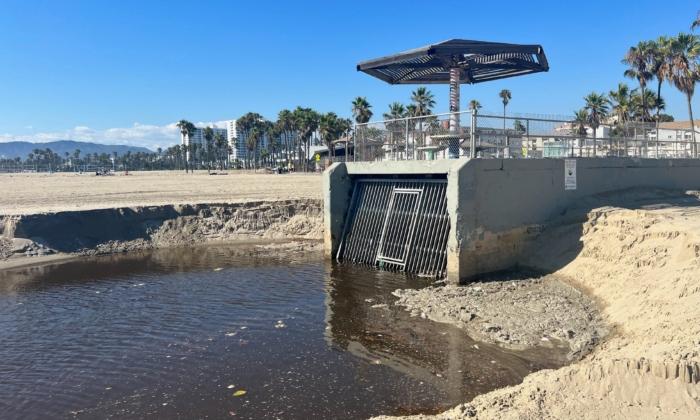Some wastewater treatment plants in California have been releasing excess human sewage into rivers, a water expert stated.
Bob Bishel, who spent years in the water treatment industry, told The Epoch Times: “What happens in all of our rivers, streams, and lakes is they’re dumping the sewage, treated and untreated, into all these bodies of water. And then when they don’t have enough fresh water to wash it out to the ocean, you will have a blue algae outbreak, and that’s on human waste.”
Despite the heavy rain California has received over the past few months, millions of gallons of water was flushed to the ocean every day instead of being captured for future droughts. Debates around the floodwater have been nonstop, with one side calling for the water to be saved in reservoirs and the other side arguing that the water needs to be released to protect endangered fish and other species.
However, there is another reason the river water is often not being utilized: It’s too dirty to be taken.
Mr. Bishel said flushing sewage has been an open secret for many years.
“They’ll talk to you off the record, but they’re not going to talk to you on the record because they’ll lose their jobs,” he said.
Mr. Bishel currently works for a water equipment company, which provides solutions to farmers and municipalities to treat contaminated water and make it reusable for agricultural purposes. He said many wastewater treatment plants are outdated and unable to keep up with the requirements.
“They do have state-of-the-art sewage facilities now that are superior to the old ones. But we have old dinosaur technology out there still in all these major towns and counties, always located next to bodies of water,” Mr. Bishel said.
Releasing untreated wastewater can not only contribute to harmful blue algae blooms but also affect reservoirs downstream. Mr. Bishel said due to the poor water quality, facilities like San Luis Reservoir are not able to run at full capacity.
“They say that there’s too much turbidity in the water ... to pump over there. That’s sewage water in rivers, so they know they don’t allow it to be pumped up into reservoirs. [They’re] flushing that all out to the ocean, so we lose all this water every year. Last year was one of the wettest years in 100 years, and so much of that water got wasted out to the ocean,” said Mr. Bishel.
San Luis Reservoir is the fifth largest reservoir in California, with 2 million acre-feet of storage. Its water is pumped from the Delta through O’Neill Forebay and delivered through California Aqueduct to consumers in central California.
According to reports, San Luis Reservoir has also been plagued by algae blooms over the past six years. Warnings and notices of harmful levels of algae were issued almost every year in the area.
Mr. Bishel said that when the reservoir operators won’t pump certain water, they say it’s because of the fish.
“It’s not because the fish,” said Mr. Bishel. “It’s because of turbidity and [the] sewage level is too high.”
He said they don’t want the sewage to go up and contaminate the reservoirs.
He said the state has initiated some projects to upgrade the wastewater treatment plants, but due to high cost, the process is slow. He also mentioned that the lack of discussion and investigation leads to misconceptions and even tensions among different groups.
“They just blame the farmers, and they just pass the buck, and then everybody’s happy and they just go on with their life. But if you ignore a problem long enough, it just keeps getting bigger and bigger and bigger, and that’s what’s happening,” Mr. Bishel said.
Mark Nakata, a fifth-generation farmer from Central California, said in an interview with Bay Area Innovators: “Anybody could take up an empty water bottle ... go to the local body of water, they can take a sample, take it down to a lab and test it. You’ll be shocked at what’s in it.”
Mr. Nakata said the Delta water has been intentionally flushed to the ocean because they’re trying to eliminate the sewage, which is released into the river when the runoff is so big that it goes over the capacity of the wastewater treatment plants.
“But they’re not telling you,” Mr. Nakata said. “When you get a lot of rain, they’re releasing treated and untreated sewage out to the river. … It’s not fertilizer, nitrates. It’s raw human sewage.”
According to a 2023 report from Bay Nature, human waste contributes 65 percent to the total organic load annually that causes destructive blue algae bloom in the San Francisco Bay. The algae blooms are more likely to happen during the summertime because less water is mixing into the Bay.
To reduce the concentration of the nutrients and prevent future algae bloom, several environmental groups asked for an increase in the water flow from the San Joaquin River to the Delta.
The group filed a petition to the State Water Resources Control Board in 2022, stating that a minimum level of 40 percent is required in the dry season to “help fish and wildlife and potentially flush out the organisms causing the bloom.”






